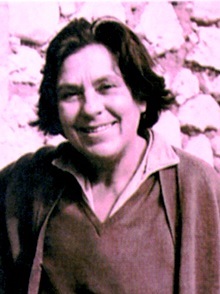Halet Çambel facts for kids
Quick facts for kids
Halet Çambel
|
|
|---|---|
 |
|
| Born | 27 August 1916 |
| Died | 12 January 2014 (aged 97) Istanbul, Turkey
|
| Resting place | Akyaka, Muğla, Turkey |
| Nationality | Turkish |
| Education | Archaeology |
| Alma mater |
|
| Occupation | Archaeologist |
| Spouse(s) | Nail Çakırhan |
| Awards | Prince Claus Award |
Halet Çambel (born August 27, 1916 – died January 12, 2014) was an amazing Turkish woman. She was a talented archaeologist who studied ancient history. She was also an Olympic fencer, which means she competed in the sport of fencing. Halet Çambel made history as the first Muslim woman to ever compete in the Olympic Games.
Contents
Her Early Life and Education
Halet Çambel was born in Berlin, Germany, on August 27, 1916. Her father, Hasan Cemil Bey, was a Turkish military officer. He worked closely with Mustafa Kemal Atatürk, who founded the country of Turkey. Her mother, Remziye Hanım, came from an important family too. Her grandfather was a former prime minister of the Ottoman Empire.
Halet went to the American High School for Girls in Istanbul. There, her art history teacher inspired her. She loved visiting Istanbul's historic places. During this time, she also started learning to fence.
Studying Archaeology
From 1933 to 1939, Halet studied archaeology at Sorbonne University in Paris, France. After finishing her studies, she returned to Turkey. In 1940, she became a scientific assistant at Istanbul University. She earned her doctorate degree in 1944.
Halet became a lecturer at the university in 1947. She also spent two years as a visiting scholar in Germany. In 1960, she became a professor. She even started the Institute of Prehistory at Istanbul University. She retired in 1984.
Family Life
After competing in the 1936 Summer Olympics, Halet met Nail Çakırhan. He was a poet and journalist who later became a famous architect. They were married for seventy years. Nail Çakırhan passed away in 2008.
Halet Çambel died in Istanbul on January 12, 2014. She was 97 years old. After a special ceremony, she was buried next to her husband.
Olympic Sports Career
Halet Çambel was a talented athlete. She competed in the women's individual foil fencing event. This was at the 1936 Summer Olympics held in Berlin, Germany.
She was the very first Muslim woman to compete in the Olympic Games. During the Olympics, she was invited to meet Adolf Hitler. However, Halet Çambel refused to meet him. She did this because she disagreed with his political views.
Archaeological Discoveries
After World War II, Halet Çambel began working with a German archaeologist. His name was Helmuth Theodor Bossert. He was a professor at Istanbul University.
Excavating Karatepe
In 1947, Halet and Professor Bossert started digging at a place called Karatepe. This was an ancient walled city from the 12th century BC. It belonged to the late Hittite king Azatiwada. Karatepe is located in the Taurus Mountains in southern Turkey.
Halet Çambel played a very important role in understanding ancient writings. At Karatepe, they found a special stone called the Karatepe Bilingual. This stone had the same text written in two languages. One was in Hittite hieroglyphics, and the other was in the Phoenician alphabet. This discovery helped experts finally understand the Hittite hieroglyphs.
Protecting Cultural Sites
Halet Çambel also worked hard to protect Turkey's historical sites. In the 1950s, the government wanted to move artifacts from Karatepe to a museum. Halet fought against this idea. She believed the artifacts should stay where they were found.
The government eventually agreed with her. In 1960, they created an outdoor museum at Karatepe. It is called the Karatepe-Aslantaş Open-Air Museum. Her husband, Nail Çakırhan, even designed some of the buildings there.
Halet also stopped a plan to build a dam on the Ceyhan River. This dam would have flooded many important archaeological sites. She managed to get the water level lowered. This saved the ancient sites from being destroyed.
Awards and Recognition
In 2004, Halet Çambel received the Prince Claus Award. This award came from the Netherlands. The award recognized her efforts to save endangered historical sites. It also praised her work in restoring ancient stones. She made sure that Turkey's cultural heritage was properly preserved.
The award also honored her for starting the Prehistoric Archaeology department at Istanbul University. It celebrated her dedication to learning. It also recognized her special role in helping people connect with their cultural history.
See also
 In Spanish: Halet Çambel para niños
In Spanish: Halet Çambel para niños

